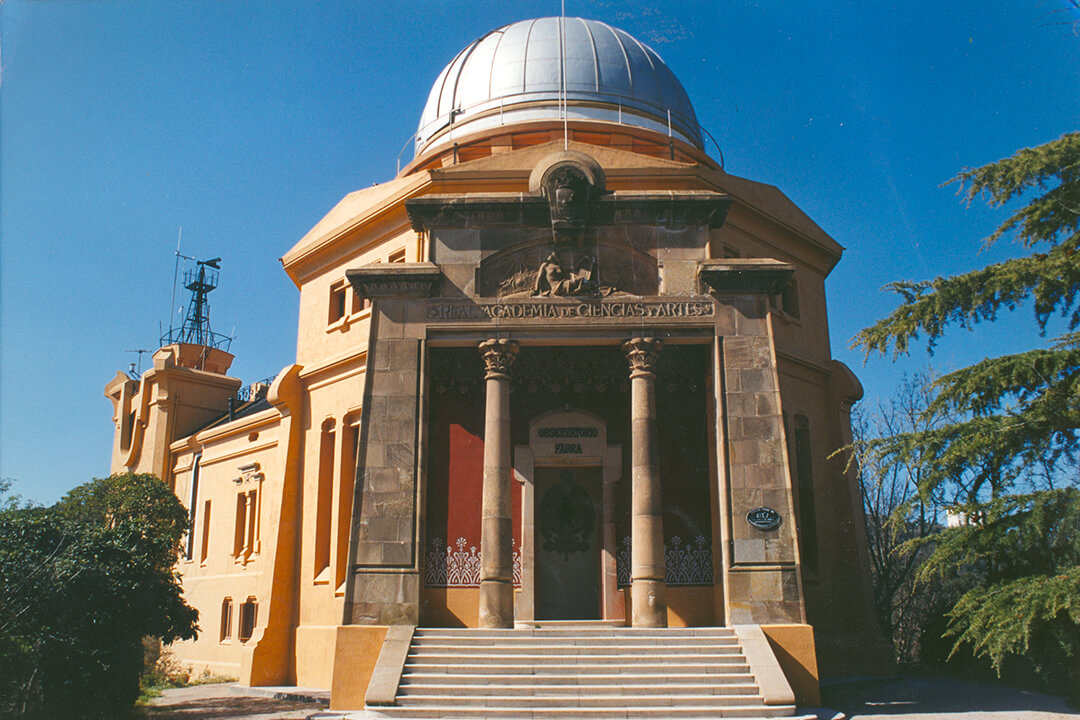
The OBSERVATORI FABRA (112). (FABRA OBSERVATORY) belongs to the Barcelona Royal Academy of Arts and Sciences, which is in charge of its operation and maintenance. Opened in 1904, the building was designed by the Barcelonan architect Josep Domènech i Estapà. The origin of the Fabra Observatory goes back to the year 1900, when Camil Fabra, the philanthropic industrialist who became first Marquis of Alella, donated a handsome legacy for the construction of an astronomical, meteorological and seismic observatory on Tibidabo. Construction began in 1902 and was completed two years later in 1904. The building, formed by the juxtaposition of three clearly differentiated bodies (one octagonal, one rectangular and the other in the shape of a cross), is the result of the typical eclectic approach of Domènech i Estapà in dealing with the special purposes for which it was intended. The rectangular volume, ending in a crossing, is cut in two by the vertical opening required for the operation of research equipment, and the octagonal body is crowned by a rotating metal dome, housing the telescope. On the seaward side, the building is decorated by a classically inspired porch which boasts two Neo-Egyptian columns and a pediment with very unusual shapes. The pediment also features a bas-relief depicting the figure of a half-naked woman holding an astrolabe in her left hand. The figure is surrounded by representations of planets and stars, among which you can recognise the Sun and Saturn, so it may be said to be an allegory of astronomy. Astronomical activity began in 1905 with the observation of an eclipse and has never stopped since, although the most relevant scientific contribution to astronomy were Josep Comas i Solà’s observations and discoveries between 1915 and 1930. Research is still carried out at the Fabra Observatory, but a space has been opened for educational activities and to popularise astronomy among the general public. A new project aimed at schools has started as well as a cycle of night-time observations entitled “Barcelona’s Sky” intended to show visitors the heavenly bodies that can be seen from the city. An interesting option are the “Suppers under the Stars”, in which the visit includes dinner at the garden, a visit to the observatory and the chance to have a glimpse at the stars through its great century-old telescope (only in July, August and September; it is required to book in advance).
Actions on Modernista Heritage City Council Programme Barcelona, posa’t guapa (Barcelona, get pretty)
Restoration of façades.
Timetable
Night visits
All year round schedules follow the astronomical calendar.
Daytime visits
Sunday and public holidays al 11.00am, 12.00am and 13.00pm. Closed: From December 25th to January 6th, Holy Week and August.
Previous booking is not required.
Prices and discounts
Night visits
The sky at night: Fridays, €15.00
Discount of the Modernisme Route: 25%, not applicable to daytime visits, Saturdays or visits including dinner.
Daytime visits
2,00€.
This offer is not extended to the discount vouchers of the Modernisme Route.
More information
Night visits: tel. (+34) 931 701 797 (Sternalia).
Daytime visits: tel. (+34) 93 417 57 36 (Observatori Fabra).
From the mountain top, it is a nice stroll down Carretera de Vallvidrera al Tibidabo. From Barcelona, you need a taxi or private transport: follow Carretera de Sant Cugat and turn at Carretera de Vallvidrera al Tibidabo.
Get the Guidebook of Barcelona Modernisme Route
The Barcelona Modernisme Route is an itinerary through the Barcelona of Gaudí, Domènech i Montaner and Puig i Cadafalch, who, together with other architects, made Barcelona the great capital of Catalan Art Nouveau. With this route you can discover impressive palaces, amazing houses, the temple that is symbol of the city and an immense hospital, as well as more popular and everyday works such as pharmacies, shops, shops, lanterns or banks. Modernisme works that show that Art Nouveau took root in Barcelona and even today is still a living art, a lived art.
The Guidebook of Barcelona Modernisme Route can be acquired in our centers of Modernisme.

